
History
A properly selected bit is the key to correct, soft and flexible communication with the horse. Choosing “the one" is often difficult for riders at all levels, because matching an eagerly accepted mouthpiece depends on many different factors. Each horse has its individual preferences, character and temperament, which the bit is designed to combine with the rider's skills so that the cooperation runs harmoniously, with full acceptance of the contact. However, with the implementation of training goals, changes due to the age of the horse, an increase in the level of pair’s skills or a switch in the type of training, another kind of bit might be needed.
Gel Bits System is based on a unique gel specially designed for our needs. This material is pleasant to touch, eagerly chewed and accepted by horses, and at the same time is distinguished by its extraordinary resistance to biting. The mouthpieces we offer vary in shape and flexibility, so that every rider can match the horse's needs.
We have encountered multiple situations when the horse perfectly accepted the mouthpiece, but the whole bit's action was too strong or too weak. Our befriended riders dreamed that it would be possible to change the cheek pieces in the horse's favorite bit. When designing our product we took these dreams into account and realized them in the form of the innovative Winderen Gel Bits System, making the process of selecting the best bit for your horse as easy as never before.
While creating the system of interchangeable cheek pieces and mouthpieces, we wanted to maximally facilitate and optimize the process of selecting a bit, and then simplify its adaptation to the changing needs of the pair. Our system allows you to connect any mouthpiece with the entire range of cheek pieces offered, which gives you unlimited possibilities to modify Winderen bit.
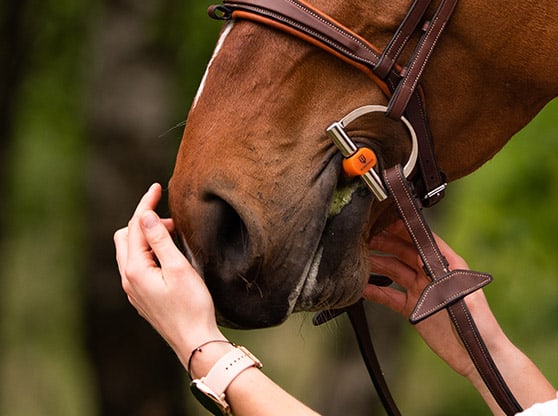
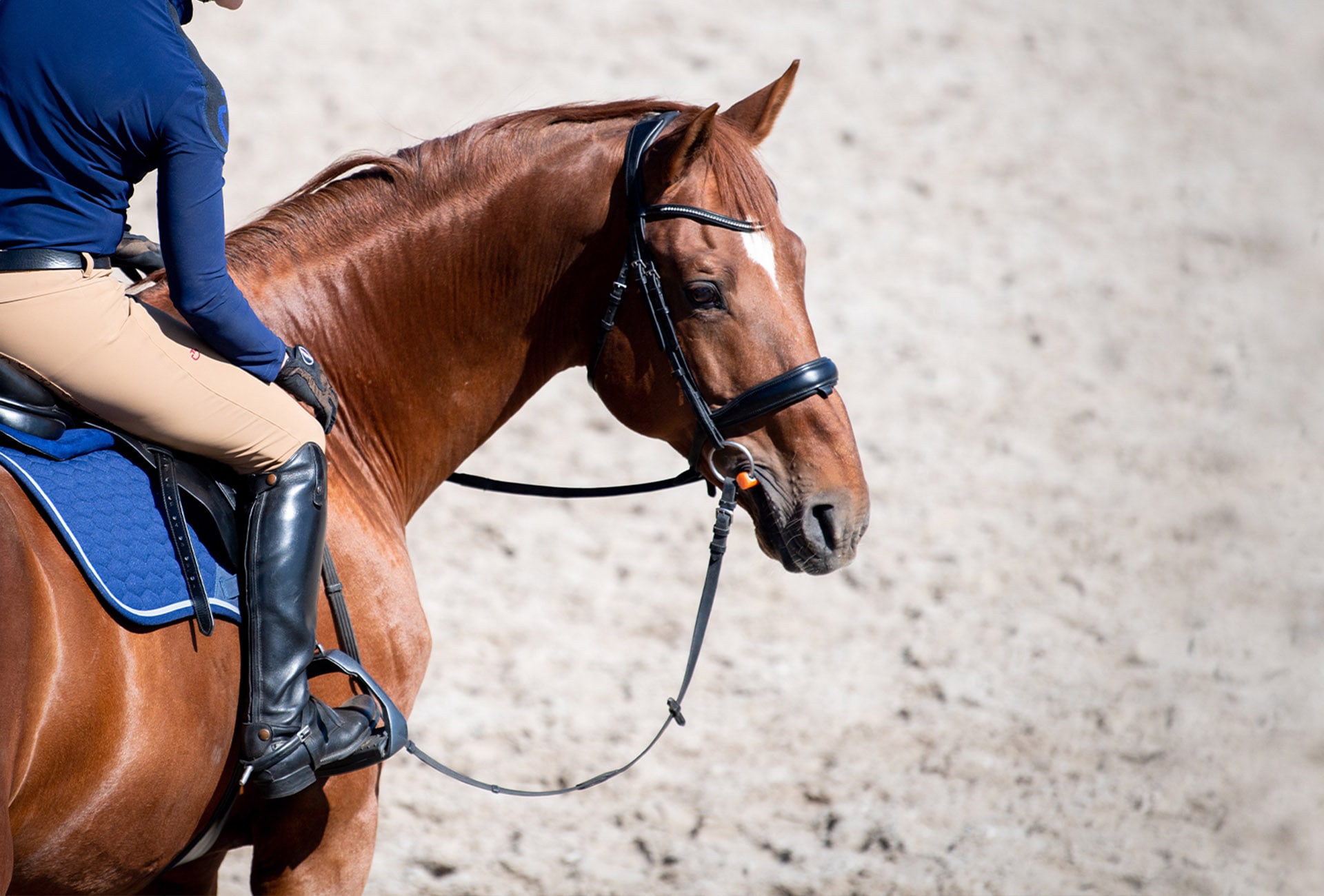
Because each type of bit has a specific action that must be understood by the horse, below we have prepared a brief description of the individual elements and combinations of our bits. It should be remembered that the selection of the best bit should begin with learning the principles of its functioning and choosing the right size.
Super Flexi Mullen Mouth - the mildest of our mouthpieces range
Very high flexibility and anatomical shape, with a very mild port in the central part which is making the bit evenly arranged on the tongue, ensuring freedom of chewing. It has a flexible metal core.
Recommended for horses: young, delicate in mouth, with a tendency to go easily behind the contact.
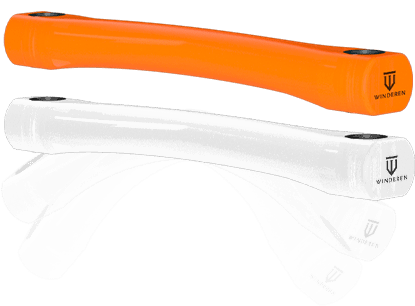
Flexi Mullen Mouth - the most universal of our mouthpieces range
This bit maintains all the advantages of the anatomical shape of Super Flexi, but inside it has a metal core with less elasticity. Optimal flexibility and arrangement in the mouth make it a universal bit.
Recommended for all horses without contact problems.
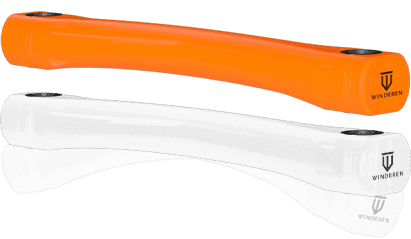
Single jointed - gel mouthpiece with a non-invasive joint
This model consists of two movable parts with a rigid steel core. They are connected by a metal joint that allows the bit elements to move independently. The length of both parts of the mouthpiece is covered with a horse-friendly gel material, protecting the corners of the mouth, the sides of the tongue and the edges of the jaw from pinching. These features allow the bit to fit comfortably in the mouth, being more pleasant for the horse, while maintaining the functionality of a traditional single-jointed bit. This type of mouthpiece acts primarily on the edges of the jaw, the sides of the tongue and the corners of the mouth. It is an ideal solution for horses that prefer broken bits without excess pressure on the tongue. The single-jointed mouthpiece transfers the action of the rider's hand primarily to the jaw, which is also protected against uncomfortable pressure by a layer of horse-friendly gel.
Recommended for horses that need to be ridden with heavier contact and do not like direct pressure on the tongue.
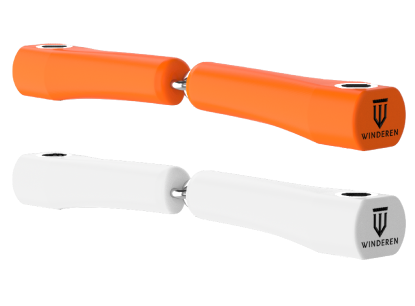
Double Broken Mullen Mouth - an innovative hybrid of the traditional Mullen Mouth and Double-jointed mouthpieces
At its core, this mouthpiece has 3 movable parts connected to each other. However, on the outside, the entire length of the mouthpiece is covered with our unique horse-friendly gel material, covering all joints while maintaining the required movement. This unique solution makes the mouthpiece anatomically fit to the horse’s mouth, at the same time helping prevent the tongue, palate, mucous membranes, and corners of the mouth from pinching and eliminating any nutcracker action. All these features make the Double Broken Mullen Mouth mouthpiece much more gentle to the horse’s mouth while offering the same action as a traditional double-jointed version. This type of mouthpiece sits nicely in the mouth, distributing pressure evenly around the tongue and transferring the action of the rider's hand directly to the corners of the mouth. It is an ideal solution for horses preferring synthetic gel bits and riders looking for more precise action than straight flexible mouthpieces.
Recommended for all horses with no contact problems.
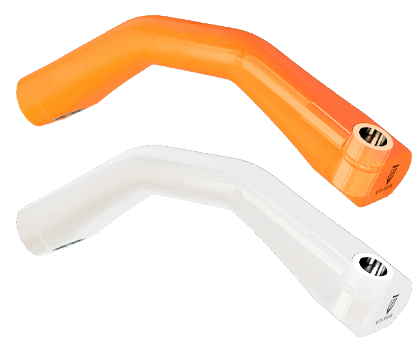
Rigid Mullen Mouth - stiff mouthpiece with anatomical shape
The bit has a completely rigid core, and at the same time maintains the shape of the anatomical Super Flexi, which is well accepted and liked by horses. The mouthpiece does not bend, which distributes the pressure evenly on the tongue and the corners of the mouth. The rider's hands movements are very clear to the horse.
Recommended for horses: not respecting the rider's hand, requiring contact correction.
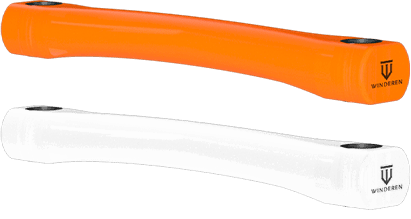
Ported Mullen Mouth - the most powerful of our mouthpieces range
The large, arcuate port in the central part leaves room for the tongue, provoking the horse to more intense chewing and making it difficult to put tongue over the bit. This shape transfers part of the pressure from the tongue to the corners of the mouth, strengthening the effect of the bit. Thanks to the completely rigid core, the bit does not bend.
Recommended for horses: going forward, not respecting the rider's hand, requiring contact correction, putting the tongue over the bit.
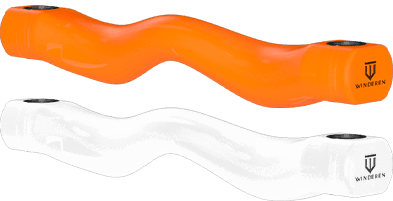
Ported Mullen Mouth with Bit Guards
While maintaining the characteristics of a regular ported mullen mouth, we've added integrated bit guards that are designed to stabilize the bit in the horse's mouth. It allows you to act not only on the jaw, tongue and corners of the mouth, but also on the cheeks.
Recommended for horses: with very sensitive mouth corners, misaligning the jaw while riding, having trouble turning.
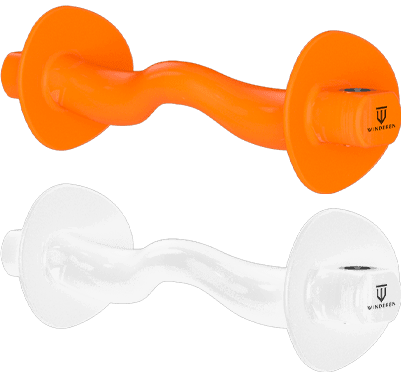
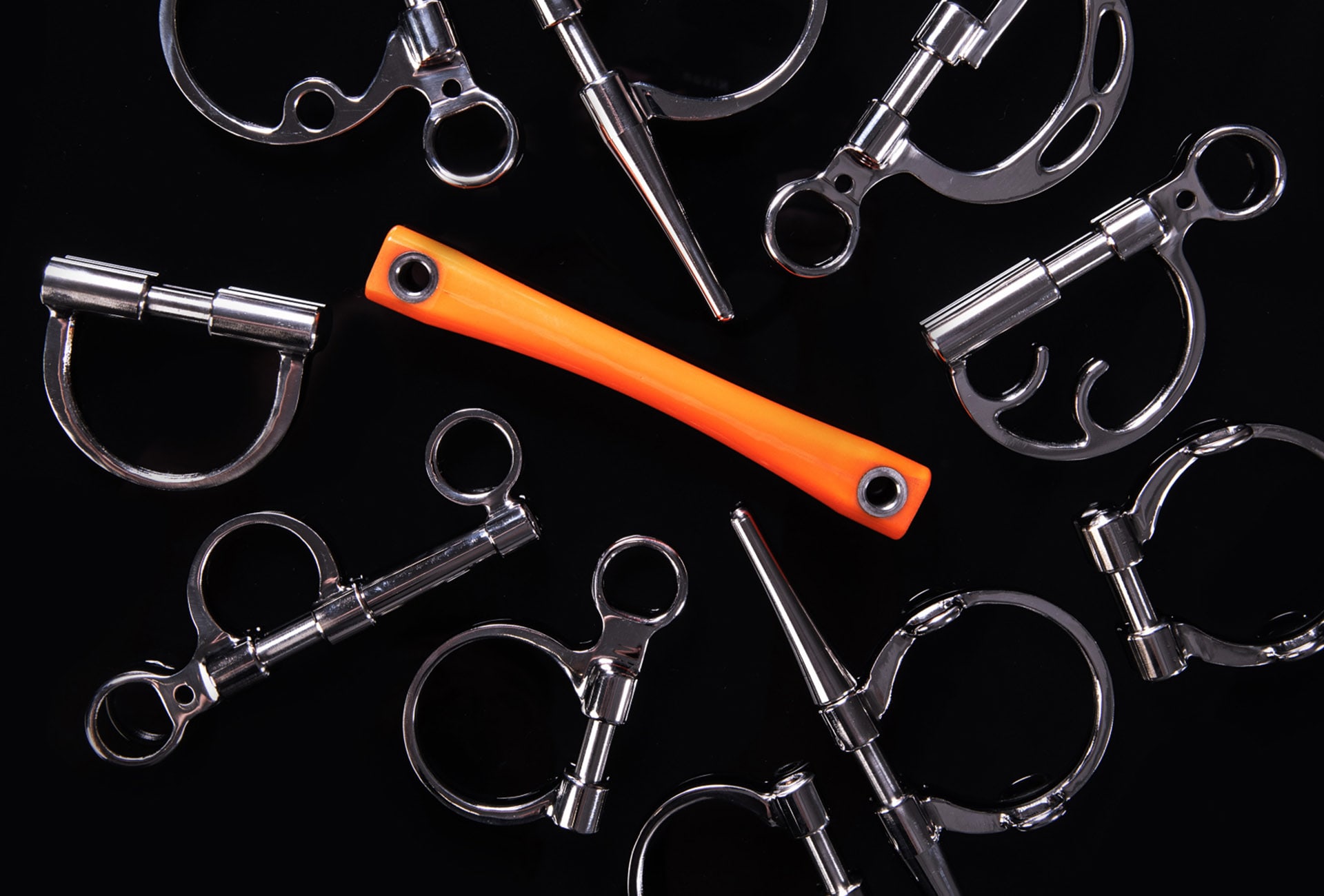
Eggbutt
Has oval bit rings, fixed to the mouthpiece. Thanks to this solution, the corners of the mouth are not pinched, and the possibility of pulling the bit through the mouth is minimized. This type of cheek pieces provides increased stabilization of the mouthpiece in the desired position, while maintaining its mobility and freedom of chewing.
Recommended for horses: young, sensitive and as a basic bit.
Recommended for riders: students with unstable hands.
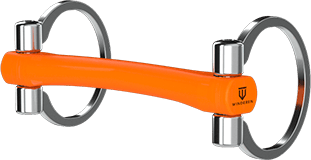
D-ring
Has D-shaped rings, fixed to the mouthpiece. It is an intermediate choice between an eggbutt and a full cheek. Due to its shape, it stabilizes the bit in the mouth and creates a little lever transferring a small amount of pressure to the poll.
Recommended for horses: young, sensitive, with a tendency to move forward and as a basic bit.
Recommended for riders: students with an unstable hand, in need of a bit with a little bit more precise effect than eggbutt.
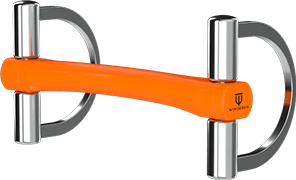
Hunter D-ring
Has big, D-shaped rings, fixed to the mouthpiece. This shape ensures a very stable position of the bit, preventing it from sliding sideways, by applying pressure to the corners of the mouth and cheeks. Due to its shape, it stabilizes the bit in the mouth and creates a little lever, transferring a small amount of pressure to the poll. Additional pressure points make it easier to control horses that do not understand the contact well.
Recommended for horses: young, sensitive, with a tendency to move forward, having trouble turning, misaligning the poll, misaligning the jaw while riding, opening the mouth.
Recommended for riders: students with an unstable hand, in need of a bit with a little bit more precise effect.
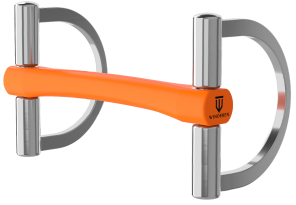
Full Cheek
Has rings fixed to the mouthpiece with arms extended above and below it. This shape ensures a very stable position of the bit, preventing it from sliding sideways, by applying pressure to the corners of the mouth and cheeks. Additional pressure points make it easier to control horses that do not understand the contact well.
Recommended for horses: young, having trouble turning, misaligning the poll, misaligning the jaw while riding, opening the mouth.
Recommended for riders: students with unstable hands, riders who don’t have a lot of strength.
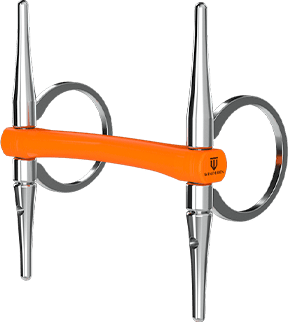
Baucher
Has rings in a shape of a small "b", where the reins are attached to the belly of the letter, and in the upper part there is an additional ring to fix the bit straps. This construction makes the bit lay stable in the mouth. While taking the contact, the extended attachments of the cheek pieces create a small lever, transferring some of the pressure to the poll.
Recommended for horses: with a tendency to lean excessively on the bit, who like to go above the bit.
Recommended for riders: in need of a more precise bit, riders who don’t have a lot of strength.
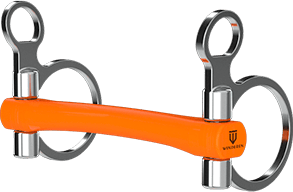
Eggbutt Gag
Has holes bored into the top and bottom of the rings, allowing to pass a dedicated round strap, vertically through the cheek pieces, connecting the cheek strap directly to the reins. While taking the contact, the bit is pulled up. This type of bit ensures the impact directly on the poll and on the corners of the mouth. Eggbutt gag is usually used with two pairs of reins, one attached directly to the bit ring and the other to an additional, dedicated strap.
Recommended for horses: pulling the bit, with a tendency to lean excessively on the bit, carrying their head too low.
Recommended for riders: having the ability to use two pairs of reins, aware of the movement of their hands.
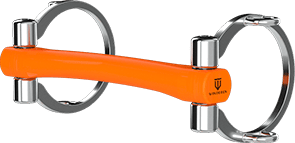
Full Cheek Gag
This combination retains all the advantages of an eggbutt gag, additionally combining them with the advantages of a full cheek. Thanks to this, we obtain a very stable position of the mouthpiece, preventing it from sliding sideways by exerting pressure on the corners of the mouth and cheeks.
Recommended for horses: with a tendency to lean excessively on the bit, carrying their head to low, having trouble turning, misaligning the poll, misaligning the jaw while riding, opening the mouth.
Recommended for riders: having the ability to use two pairs of reins, aware of the movement of their hands.
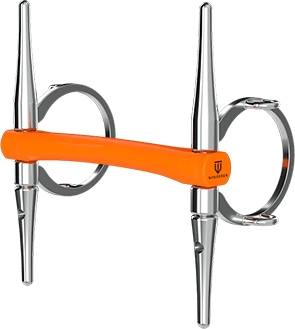
Pelham
Pulls together the advantages of the double bridle in one bit. There are three rings on one shank: the upper ones used to fasten the cheek straps, it also has hooks for fastening the curb chain; middle ones for attaching snaffle reins and the bottom ones for fastening the curb reins. Its strength is regulated by the length of the shank (we offer short, medium and long shanks) and the length of the curb chain. Using curb reins creates pressure on the lower jaw and a strong lever effect on the poll. Can be used with two pairs of reins or with a pelham strap.
Recommended for horses: strong, going forward, excited by the atmosphere of the competition, reluctant to getting a round neck.
Recommended for riders: experienced, aware of the movement of their hands.
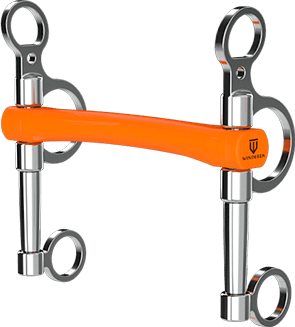
Kimblewick
This bit belongs to the Pelham category. It has the shape of the letter "D", in its upper part there is an additional ring for attaching the cheek strap and hooks for fastening the curb chain. In the middle of the letter there are two more holes for the reins (upper and lower). Most often used with one pair of reins. The strength of the bit is smaller than in the case of Pelham, and is additionally regulated by multiple options of reins attachment, changing the length of the lever.
Recommended for horses: strong, but also sensitive.
Recommended for riders: aware of the movement of their hands.
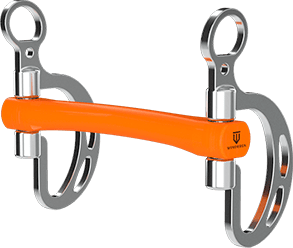
Kimblewick RNF
This bit retains all the benefits of kimblewick, but the reins holes have been replaced with open hooks.
Recommended for horses: strong, but also sensitive.
Recommended for riders: aware of the movement of their hands.
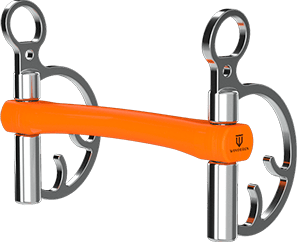
Swales Pelham
Is a modification of the traditional Pelham, designed to mimic the advantages of double bridle even better. Cheek straps are fastened directly to the movable internal bit rings, thanks to which we can interact with the mouthpiece like in an ordinary snaffle bit, exerting pressure on the corners of the mouth. Using the curb reins, we act with great force on the lower jaw. The intensity of action is regulated by the length of the shanks (we offer short, medium and long shanks) and the length of the curb chain. Can be used with two pairs of reins or with a pelham strap.
Recommended for horses: very strong, pullers, going strongly to obstacles, carrying their head too low.
Recommended for riders: experienced, aware of the movement of their hands.
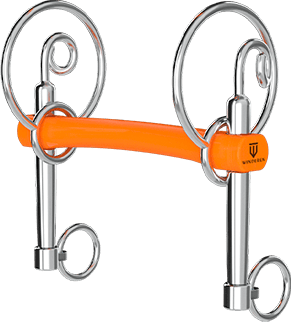
Liverpool Pelham
This Pelham is designed for harnessed horses. The cheek eyes are slightly out curved to help the bit fit better on horses with wider mouths. The reins can be attached in 5 different ways which are giving different outcomes. The mildest option, and the only one without lever effect, is attaching the reins to the snaffle ring. Then we can attach reins lower and lower - first right under the mouthpiece and later in the shanks holes intended for that purpose. The intensity of bit action is regulated by the length of the curb chain and by the reins placement - the lower the reins are, the stronger pressure on the lower jaw and poll is created.
Recommended for horses: in driving training.
Recommended for drivers: experienced, aware of the movement of their hands.
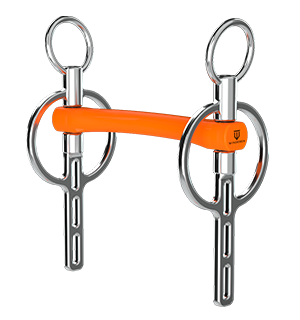
Curb
Used together with a snaffle bit in the double bridle. In its upper part there are rings for attaching the cheek straps and hooks for fastening the curb chain. In the lower part there are rings for attaching the curb reins. It works with great force on the lower jaw and poll. Allows raising and rounding the neck in higher class dressage. Its strength is regulated by the length of the shanks (we offer short, medium and long shanks) and the length of the curb chain.
Recommended for horses: very well trained.
Recommended for riders: experienced, capable of causing two pairs of reins.
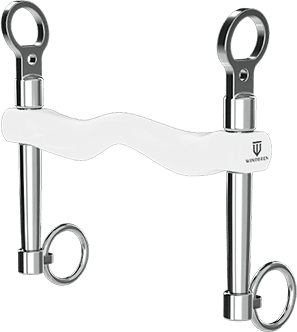
We have also introduced 6 types of popular bit models, which, due to their specific construction, could not be included in the system of interchangeable cheek pieces.
Loose Ring
It has rings loosely passing through the mouthpiece. This is the simplest and, at the same time, the most popular bit. The rider's hand has a direct effect on the corners of the mouth. Its strength depends on the type of mouthpiece chosen (all types available).
Recommended for all horses.
Recommended for riders of all levels.
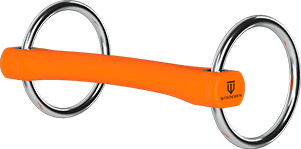
Large Loose Ring
The large bit rings ensure a more stable position of the bit in the mouth, making it less liable to move sideways by leaning on the cheeks. Thanks to this, the effect is similar to that of full- cheek cheekpieces, facilitating turns and preventings the bit from being pulled through the mouth. Additionally, larger bit rings provide a slight leverage effect which enhances the bit action.
Recommended for horses that have trouble turning, cross the jaw while being ridden, or tend to move forward.
Recommended for riders: who want a bit with more precision than a standard loose ring.
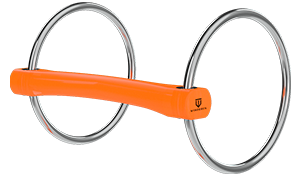
Scourier
The Scourier bit is a twin bit with four rings. The pair closer to the mouth attach to the cheek pieces, and the pair located on the outside attach to the reins. This allows the action of the rider's hand to be transferred directly to the horse's mouth, and when the reins are pulled, the inner rings additionally press on the sides of the mouth, strengthening the bit's action.
Recommended for horses that: pull on the bit; have a tendency to lean excessively on the bit.
Recommended for riders: who are experienced and aware of the movement of their hands.
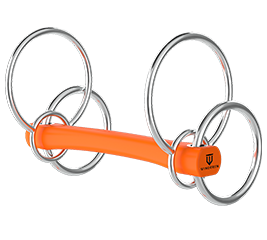
2.5 ring
Has 3 overlapping rings of different sizes. Upper one used to fasten the cheek strap; middle ring, the largest, which loosely passes through the mouthpiece and the lower one used to attach reins. While taking the contact, the bit is pulled up, causing a strong pressure on the corners of the mouth and increased pressure on the poll. The lowest ring is additionally divided into two parts. By fastening reins closer to the mouth, we increase the length of the lever, thereby increasing the strength of the bit. It can be used with one or two pairs of reins, as well as with a pelham strap. Available with all mouthpieces models.
Recommended for horses: going forward, carrying their head too high.
Recommended for riders: experienced, aware of the movement of their hands; riders who don’t have a lot of strength.
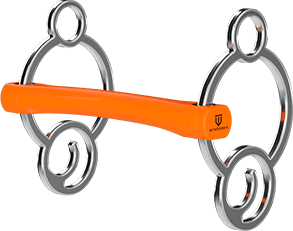
American Gag
Has 3 rings located on the shank. Upper one used to fasten the cheek strap; middle ring, which loosely passes through the mouthpiece and the lower one used to attach reins. While taking the contact, the bit is pulled up, causing strong pressure on the poll and increased pressure on the corners of the mouth. It can be used with one or two pairs of reins, as well as with a pelham strap. Available with all mouthpieces models.
Recommended for horses: going forward; carrying their head too high, but at the same time with sensitive corners of the mouth.
Recommended for riders: experienced, aware hand actions; people of low strength.
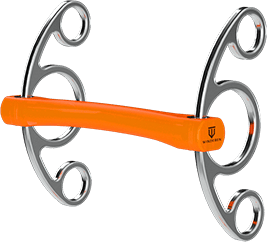
Beval
Has special eyelets on the bit rings to attach the reins and cheek straps, between which the mouthpiece can slide freely. The great advantage of this bit is that the rider can choose from a variety of different ways to attach the reins and cheek straps.
Recommended for all horses, and for horses that need different bit actions depending on changing work schedules.
Recommended for riders of all levels as well as those actively looking for an effective bit for their horses.
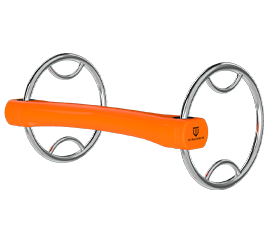
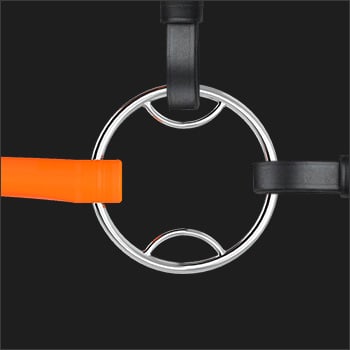
Attach the cheek straps to the eyelet and the reins freely to the bit ring to make the beval bit work like a regular snaffle.
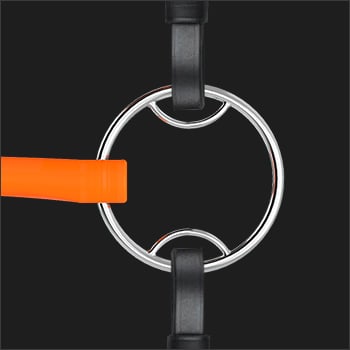
Attach both reins to the eyelets to make the bit work like a delicate 2.5 ring bit, putting slight pressure on the poll and at the corners of the mouth.
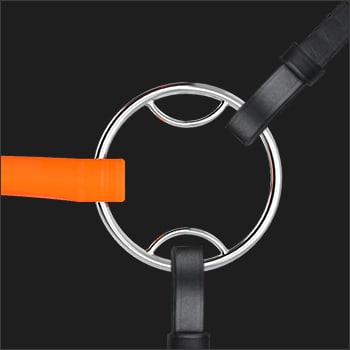
Attach the cheek straps freely to the bit ring and the reins to the eyelet for increased pressure on the tongue and lower jaw.
Remember that the bit is only a means to communicate with the horse. Creating a well-functioning, harmonious pair is based on time spent together on training, mutual trust, freedom and comfort of the mount. The horse will respond correctly to signals from the rider's hand only when it fully accepts the bit. To support this process, we have created well-lying bits that encourage chewing and loosening the jaw, which increases both-sided comfort and riding pleasure.
Knowledge Zone
-
Choosing and adjusting the bit - where to begin
When looking for the best bit for your horse, remember that it is not only type, shape or materials that will affect the quality of contact. The first very important step in selecting a bit is to have a vet check the horse's teeth and general condition of the inside of the horse's mouth...
Read more -
Technology that supports muscles and joints
"Add more leg!" Each of us has heard these words from the trainer many times. There is nothing surprising about it - after all, legs are key riding aids. However, while fulfilling their function, they are subjected to enormous loads while riding...
Read more